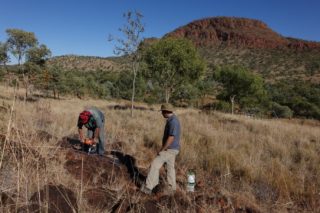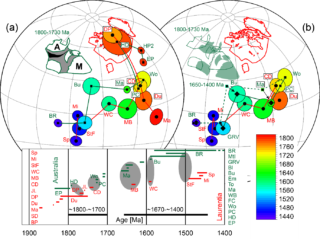Supercontinent Nuna formed in two stages
While there exsits a general consensus regarding the configuration of the Earth’s youngest supercontinent, Pangea, much uncertainty still surrounds that of arguably the oldest supercontinent, Nuna. Recent work suggests Nuna’s final assembly was not completed until ca. 1600 Ma, and that the preceding interval of ca. 2000–1700 Ma might represent a time when the building blocks of Nuna, including proto-Laurentia, proto-Australia and proto-Baltica were assembled.
Current paleomagnetic constraints are still insufficient for establishing a detailed paleogeography for this assembly process. This is especially true for one of the key continent-continent connections in building Nuna, the speculated connection between western Laurentia and eastern proto-Australia. A 1976 preliminary study of the ca. 1.8 Ga Hart Dolerite in the eastern Kimberley craton, north-western Australia, showed some promising results, although a subsequent study in 2008 in western Kimberly proved to be less successful. We undertook a meticulous sampling of the Hart Dolerite from the eastern Kimberley craton (Fig. 1), which yielded well defined paleomagnetic directions with dual polarities. A comparison of our resulting paleopole with other Australian poles for the period of 1800-1600 Ma indicates that proto-Australia, as a whole, underwent only very minor amounts of plate motion during that time. Our published results, along with existing data, also support the previously interpreted 40° intracontinental rotation between the North Australia and South Australia cratons during the Neoproterozoic.

A comparison of the Australian poles with that of Laurentia for the time between 1800 Ma and ~1400 Ma yielded more important findings: there are two distinct segments in the apparent polar wander paths (APWPs) of both continents for that time interval, suggesting similar movements of the two continents during these two time intervals. Comparable APWPs between 1800 Ma and 1730 Ma imply that the two continents were already close to each other then and shared similar plate motions (Fig. 2a). This was followed by a ca. 1000 km relative plate motion between them before ca. 1650 Ma, leading to the final assembly of Nuna by ca. 1600 Ma. The two continents as a core part of Nuna again shared common APWPs after 1650 Ma that lasted at least until ~1400 Ma (Fig. 2b). We therefore suggest that there was a two stage assembly between Australia and Laurentia as part of the assembly of the supercontinent Nuna.

Contact person: Dr. Uwe Kirscher and Prof. Zheng-Xiang Li, Earth Dynamics Research Group, Curtin University.
Relevant publication:
Uwe Kirscher, Yebo Liu, Zheng-Xiang Li, Ross Mitchell, Sergei Pisarevsky, Steve Denyszyn, Adam Nordsvan. Paleomagnetism of the Hart Dolerite (Kimberley, Western Australia) – A two-stage assembly of the supercontinent Nuna? Precambrian Research, Volume 329, pages 170-181 (2019). doi: 10.1016/j.precamres.2018.12.026
